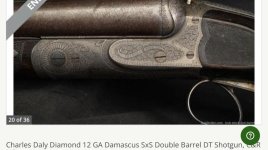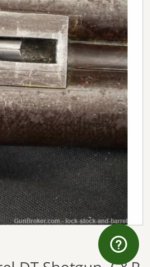To shoot or not,,Damascus bbl'd shotguns .
It's all up to the owner of the gun.
Plenty of points of view both ways and the shotgun forums are full f pages and pages of discussion on the subject.
Some of it gets nasty sometimes.
Not all are a good candidate for shooting, even with the BP loads of the era they were made in.
Not unlike any firearm, they have to be in good condition to begin with.
That starts with bbl wall thickness and solid lockup and all the things already pointed out in above posts.
Being cavalier about the whole thing and believing any damascus gun is just as strong as any steel bbl'd gun out there is foolish in more ways that one.
They all have to be checked out no matter what they are and when they were made.
When you do decide to shoot them, realize that what was a 'normal' load in 1900 pressure wise is not the same as what is now sold OTC.
Nitro Proofed back then had a different ceiling than what is considered allowable now.
Load for the specific firearm and even then consider the age and be kind to it.
Yes, smokeless powder loads can be made up that will perfectly follow the BP pressure curve of the same guage.
But they are usually not something thrown together from what you might have on hand unless you are dedicated to this sort of thing.
Specific hull, wad, crimp style, primer, shot weight and powder type and charge weight all play a role.
Estimating pressures ,,you can not.
The best data comes from actual loads checked in a Pezio pressure test gun. There are more than a few private individual companys that will pressure test your loads and give you the test results all printed out.
5 rds is usually the minimum number for an average readout.
Most of the Vintage Shotgun crowd generously shares this info on-line on the different forums.
Some may still not feel secure in using a Damascus bbl'd gun and that is their right.
Just like anything else.
Have there been times when a Damascus bbl'd shotgun bbl has blown?
Yes, easy to find example pics.
Some look suspiciously like a stuck wad blow up or perhaps an overload reload.
A thin wall in a tube from over aggressive bbl honing is another. Shooters like the bores to sparkle you realize.
No one really 'proofs' a firearm in the USA. At least not in the correct manner.
They may place an OTC 1 1/8oz load in it nd fire it off with a string around the trigger with the gun tied to a tire.
If it stays in one piece, it's blessed as 'Safe'.
Hardly...
Damasus bbl's, the century+ old ones are still treated the same ans a brand new steel bbl as far as Proofing is concerned in England and Italy.
If an old Damascus bbl'd shotgun (or rifle) comes into the Proof House it is treated no different.
It is Proof Fired with the same Smokeless Proof Loads as the new mfg firearm of the same gauge/caliber.
But before they ever get to the Proof Firing, the guns (old and New) go thru an Inspection (View Proof). That checks and measures things like headspace, lockup, chamber size, etc.
80+% of guns that FAIL proofing,,fail during View Proof.
They never get to the Proof Firing stage.
Those that fail during actual Proof Firing are as a result of the View done after that firing. What is found then are loose locking systems, bulged bbl's & chambers, and other issues arising from the actual Proof Round firing.
The incidents of bbl's 'blowing up' is a very rare occurance.
Bbl wall thickness: There is no Minimum Wall Thickness in the European Proof Hs.
They either pass or fail proof.
However an extremely thin bbl will fail View Proof.
That would be thin enough for the Proof Inspector to notice such things as the bbl wall deflecting by finger pressure, ect.
..I've seen them so thin from honing that a Bore Micrometer would push the Mic measuring ball points against the inner wall surface and actually push the wall outward.,,tissue paper thin, but nice and shiney to look thru!
Each gun is an individual piece of machinery to be examined and judged.
Even then if you don't feel comfortable using it,,Don't.
There are far too many other firearms out there to satisfy your shooting and hunting needs w/o having to doubt the safety of the one in hand every time you pull that trigger.




